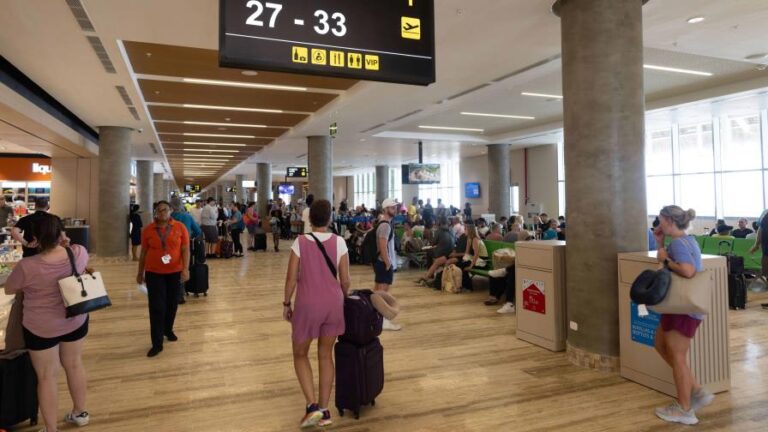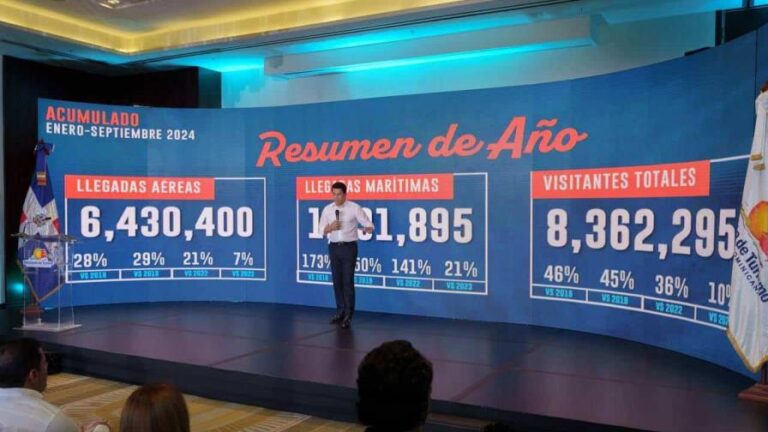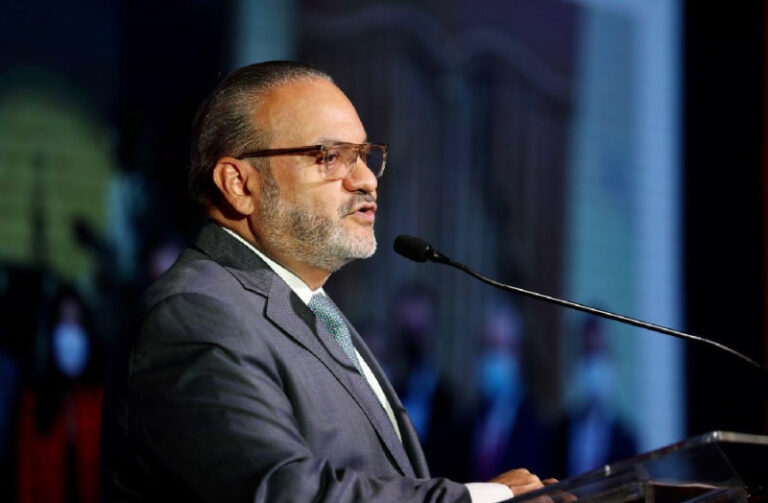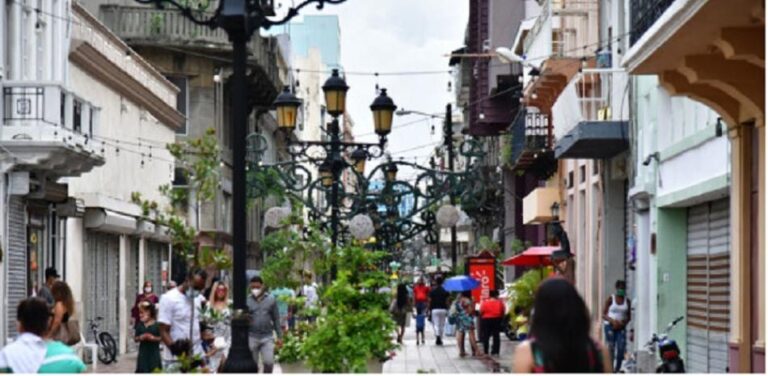A week ago, the Dominican Republic made headlines after it was reported that the Caribbean country attracted more tourists than Argentina, Brazil, and Colombia in 2022, according to data from the United Nations World Tourism Organization (UNWTO).
Brazil, which is up to 175 times larger than the average island, received 3.6 million travelers last year; however, Quisqueya, which territorially represents only 0.57% of the South American country, received more than seven million people. Colombia, on the other hand, registered the entry of 4.4 million visitors during the same period.
These numbers of foreigners also translated into income for the tourism sector. In this sense, the Dominican Republic surpassed economies twice its size and positioned itself as the third country with the most dollars generated by tourism, surpassing Brazil by almost 50% and Argentina by more than 130%. It was even higher than the sum of five Central American countries.
For the executive vice-president of the Association of Hotels and Tourism (Asonahores), Andrés Marranzini, this is due to the tourist offer, which is diversifying every day with new hotel options, activities such as horseback riding, and golf courses.
“We as a sector have made an effort in recent years to increase the daily expenditure of each tourist. Something that helps us to increase that spending is the incorporation of complementary activity within the points of encounter with the tourist, that is, where he can go to spend that money, the number of services he receives during his process of participation within the tourist ecosystem,” he told El Dinero Newspaper.
According to Marranzini, the strategy is to raise the level of quality tourist destinations. This is achieved through hotel investments, which he assures are being made.
Central America
As detailed in a report by the Central American Monetary Council (Secmca), during 2022, exports of services from Central America and the Dominican Republic (CARD) registered a “good performance”, showing an inter-annual increase of 30.9%.
As explained, the improvement was due to higher income from travel (tourism) with an increase of 59.3% compared to 2021, among other sectors. As for tourism, foreign exchange income went from US$8,691.3 million in 2021 to US$13,843.8 million in 2022, with the Dominican Republic, Costa Rica, and El Salvador being the main destinations in the region.
In fact, the half-island exceeded the combined revenues of five of the seven Central American countries by more than US$1.2 billion. While the Caribbean nation reported US$8.406 billion, Costa Rica (US$3.137 billion), El Salvador (US$1.864 billion), Guatemala (US$987 million), Honduras (US$540 million), and Nicaragua (US$595 million) together reached US$7.123 billion. In total, the group of countries totaled US$13.844 billion as of December 2022, according to Secmca data.
In the case of Panama, according to data from the Planning Directorate and the Department of Statistics, the foreign exchange income registered in the period from January to December 2022, was 4,720.6 million balboas. With the same currency value, in dollars, it amounts to US$4,722.9 million.
Mexico, on the other hand, obtained the first place for income in the tourism sector in all of Latin America. The amount amounted to US$26,346.90 million, surpassing the sum of the next three places on the list, which includes Chile, the Dominican Republic, and Colombia.
South America
When you look further down the map, it is precisely Chile that holds second place by the weight of currency in the entire region. According to the Undersecretariat of Tourism of that country, according to estimates made, the tourism industry in 2022 generated revenues of US$9,247 million, increasing by 52.9% over what was recorded in 2021, and +87.8% more than in 2020.
They explain that the total income is made up of the sum of inbound (US$1,320 million), domestic (US$7,793 million), and outbound (remaining in Chile, US$133 million). Even so, this figure has a difference of US$841 million, or 10%.
After the Dominican Republic, in fourth place, was Colombia. According to the Ministry of Commerce, Industry, and Tourism, the travel and passenger air transport sector for 2022 reported a foreign currency inflow of US$7,368 million. Ecuador’s Ministry of Tourism, for its part, reported that during the previous year, sales generated US$5,200.2 million. This figure represents an increase of 29.9% with respect to 2021. The same state organ, but from Brazil, reported that foreigners left US$4,952 million in the country in 2022.
According to the Monthly Report of Tourism Statistics, prepared by the Ministry of Tourism and Sports of Argentina, in 2022, international tourism revenues were US$3,533.2 million. That amount represented 799.7% more than in 2021 (-36.3% vs 2019). Meanwhile, outflows for the same concept were US$7,315.5 million, 291.8% more than in the same period of 2021 (-24.8% vs 2019).
In the case of Peru, the Ministry of Foreign Trade and Tourism reported that last year they reached two million international tourists, which represented less than half of the flows received in 2019 (4.4 million). In terms of foreign exchange, around US$2.8 billion was generated (-40% compared to 2019).
Uruguay, on the other hand, according to data from the Ministry of Tourism, had US$1,396 million in “inbound tourism”. In Paraguay, according to the National Secretariat of Tourism, international visitors totaled US$455 million in revenues for the country, “making tourism one of the main export products of the national economy, representing approximately 1.11% of Paraguay’s gross domestic product (GDP)”.
In the particular case of Bolivia, they only have published statistics up to October. They point out that, up to that date, domestic and inbound tourism generated an economic movement of Bs 4,307 million. In dollars, this amount amounts to some US$624.25 million.
Gross domestic product
In 2022, the tourism sector contributed 7.6% to Latin America’s GDP, contributing US$302.6 billion to the region’s economy. This represented a 34% growth compared to the previous year, according to the World Travel and Tourism Council (WTTC).
The Dominican Republic reached 7.16 million non-resident tourists and around US$8 billion in revenues. | External source.
In the case of Brazil, the Travel & Tourism sector’s GDP contribution grew by 22.7% compared to the previous year, reaching US$140.9 billion. They detail that it represented 7.6% of the Brazilian economy. In addition, it surpassed the contribution figures reported in 2019 when the sector contributed US$138.8 billion to the country.
In the case of Argentina, the contribution to GDP grew by 39% in the same period, to total US$50 billion. It represented 8% of its economy. In Colombia, the increase was 97.2%, to US$14.9 billion. This translated into 4.5% of the Colombian economy. In Peru, the variation was 34.9% and reached US$16.5 billion.
In the Dominican Republic, meanwhile, the contribution of the tourism sector grew by 26%, to total more than US$16.7 billion, which represented 15% of the Dominican economy, exceeding by 3.8% as reported in 2019.
In Chile, it was 35.4% to total more than US$28.4 billion. That meant 9.2% of the Chilean economy, just 1.7% below the figures reported in 2019. In Mexico, on the other hand, that variation was 23% and reached almost US$215 billion, and represented 14.7% of the Mexican economy. That is 2.1% below the figures reported in 2019.
Complementary supply
Hotels today, Marranzini explains to elDinero, have in-house desks within the property. This means they are integrating complementary activities into the tourist service.
“It’s a myth people have. It has always been said that tourists do not leave the hotel and that hoteliers are not interested in tourists leaving the property. On the contrary, the less they are in the tourist complex, the less they consume from the place”, he said.
For the executive, when it comes to boosting the tourism sector, “it is no longer a matter of quantity, but of quality”. By this, he is referring to activities outside the resort, such as excursions and visits to historical sites, which are becoming more and more important every day.
Job creation
In 2022, the travel sector generated more than 22 million new jobs, according to WTTC. This represents an increase of 7.9% over 2021 and only 11.4% below 2019 In Mexico, the travel industry was responsible for almost seven million jobs, or 12.2% of total jobs in the country (0.8% below 2019 levels), according to WTTC.
In Chile, meanwhile, there were 930 thousand. That figure is equivalent to 10.5% of the total. Even so, it was 5.8% below 2019 levels. In the case of the Dominican Republic, it generated 802.6 thousand jobs or 16.8% of total jobs in the country. That was 0.3% above 2019 levels.
In Colombia, meanwhile, the tourism sector generated 1.25 million jobs. That’s 5.6% of the total and was 2.6% above pre-pandemic levels.
In Brazil, it contributed some 7.6 million jobs, or 7.7% of the total and just 0.7% below the 2019 figure. In Argentina and Peru, it was almost 1.4 million jobs (10.5%) and 980 thousand jobs (5.2%), respectively.
Source:





